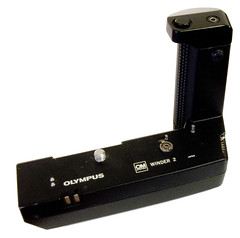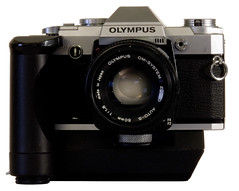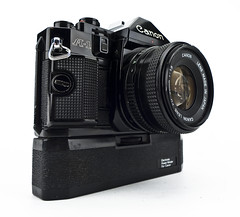Difference between revisions of "Film advance"
m (typo) |
m (Minor edit to the text to incorporate the phrase 'auto-stop', rather than make a glossary item for it.) |
||
| Line 3: | Line 3: | ||
'''Film advance''' is a mechanism for moving film from one spool to another incrementally one frame at a time. | '''Film advance''' is a mechanism for moving film from one spool to another incrementally one frame at a time. | ||
| − | Advance may be a manual process, and may be called ''winding'', ''advance'', ''wind-on'' and various other terms, and may use, for example, a ''knob'', ''key'', ''lever'', ''slider'' or ''thumbwheel''. For this method there must be some way of stopping winding when the next frame is reached | + | Advance may be a manual process, and may be called ''winding'', ''advance'', ''wind-on'' and various other terms, and may use, for example, a ''knob'', ''key'', ''lever'', ''slider'' or ''thumbwheel''. For this method there must be some way of stopping winding when the next frame is reached. Older cameras mostly use a [[red window]], through which the user must watch for numbers printed on the film backing paper. Later cameras may have some more positive 'auto-stop' method where the camera has a roller or sprockets measuring the film to lock the winding at the correct point - or the film has a single hole locating the frame, as in [[110 film|110]] and [[126 film|126 cartridge films]]. |
Some cameras use more eccentric methods, such as the [[Werra]], which has a ring around the lens for winding and the [[Voskhod]] and [[Agimatic & Agima|Agimatic]] - which have levers rotating around the lens, or the [[Unimatic II|Bencini Unimatic]], where the shutter release button is pushed sideways to wind, and the | Some cameras use more eccentric methods, such as the [[Werra]], which has a ring around the lens for winding and the [[Voskhod]] and [[Agimatic & Agima|Agimatic]] - which have levers rotating around the lens, or the [[Unimatic II|Bencini Unimatic]], where the shutter release button is pushed sideways to wind, and the | ||
Revision as of 14:37, 7 May 2020
Film advance is a mechanism for moving film from one spool to another incrementally one frame at a time.
Advance may be a manual process, and may be called winding, advance, wind-on and various other terms, and may use, for example, a knob, key, lever, slider or thumbwheel. For this method there must be some way of stopping winding when the next frame is reached. Older cameras mostly use a red window, through which the user must watch for numbers printed on the film backing paper. Later cameras may have some more positive 'auto-stop' method where the camera has a roller or sprockets measuring the film to lock the winding at the correct point - or the film has a single hole locating the frame, as in 110 and 126 cartridge films.
Some cameras use more eccentric methods, such as the Werra, which has a ring around the lens for winding and the Voskhod and Agimatic - which have levers rotating around the lens, or the Bencini Unimatic, where the shutter release button is pushed sideways to wind, and the Voigtländer Vitessa and Welta Penti - equipped with plungers. The Calypso uses the wind-on lever for releasing the shutter as well.
In many cameras, the film advance process also cocks the shutter, and, frequently, releasing the shutter unlocks the film advance - providing double-exposure protection.

|
| falling plate mechanism of the Conley Quick Shot (Image rights) |
Falling Plate
A few plate cameras - magazine cameras - (e.g. the Houghton Klito No.1) adopted a "falling plate" arrangement, where a number of plates were kept in a sprung magazine, usually behind the focal plane. After exposure, the exposed plate fell forward and down into a well, allowing the next one to move forward for use.
A related system had a magazine of plates, but a sliding mechanism to move them to the focal plane and back. This was eventually evolved into the Polaroid system of keeping a stack of film, exposing the top and then ejecting it.
Motor Drive
Many cameras - particularly later ones - have some form of automated wind-on, triggered by the shutter release. These use a clockwork mechanism (e.g. the Robot cameras or the Kodak Instamatic X-45; see Category:Spring motor), or an electric motor. On a number of SLR systems, there were add-on motor-wind devices (motor drives) produced between the 1960s and 1990s.
|
|
|


